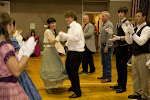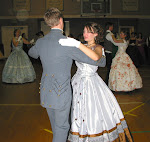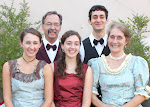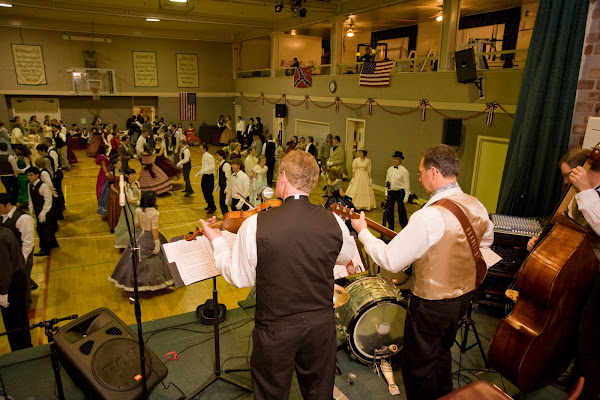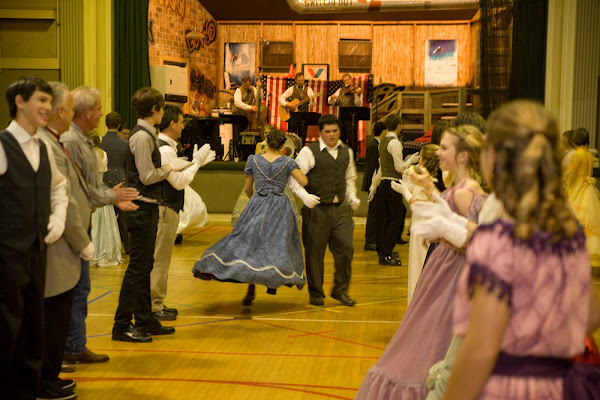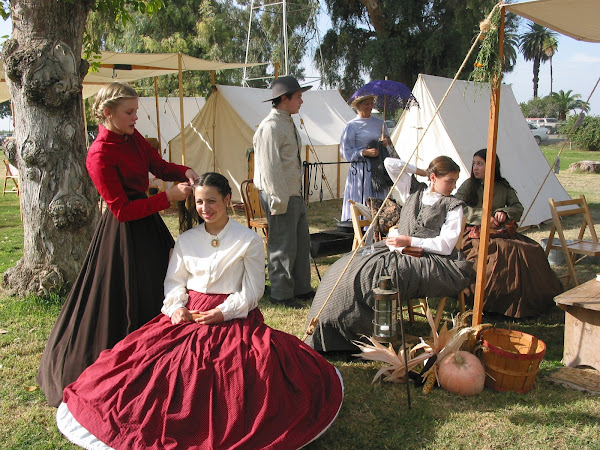Our balls are formal events, and one of the challenges is to come up with modest, elegant attire that doesn’t impact the pocketbook too severely. At the first ball that our family attended, my oldest daughter and I wore old bridesmaid dresses that I had saved from when I was in my twenties. (Yes, I save everything.) My son and husband wore slacks with shirts and vests (only $3) that I had purchased at the thrift store. As we continued to attend more and more balls, my girls sometimes wore my high school prom dress. (See, I told you that I save everything) or something we had purchased at a thrift store or garage sale.
One of the most difficult and expensive ways of providing a lady with a dress for the ball is to purchase a hoop skirt and make a period appropriate dress. After several years, my girls and I eventually did do this.
Ideas for making or purchasing period costumes can be found at:
Timeless Stitches
Abraham's Lady
HOWEVER
, there are other ways to come up with an appropriate long gown.
 |
This lace shawl is securely pinned
so that she can dance the night away. |
For the Ladies: Inexpensive dresses can be purchased at garage sales, thrift stores and off the clearance rack at Ross. But the problem with most of them is MODESTY.
I purchased a green satin gown at the thrift store several years ago that I am sure was someone’s bridesmaid dress. It was a little short on me and it had a plunging neckline, which is not acceptable at the balls. So I took a triangle of black satin material and put it in the front, and then made a strip of satin and sewed it along the bottom… and ta-da.. I was ready to go! I plan to wear it again at our Christmas Ball in December.
 |
| My Green Satin Dress |
You can also cover spaghetti straps and low cut gowns in other ways. Period appropriate coverings include Fishus, Berthas, Shawls and Bolero Jackets.
 |
This is a great Fishu over
a spaghetti strap dress. |
A Bertha is a square or oval piece of material that goes over the top of the dress neckline. There is a picture and pattern for one at the
Timeless Stitches website.
A Fishu is a long strip of material that goes around the back of the neck and shoulders, crosses in the front and then ties in the back. You can use a scarf or a shawl and tie it in this way so that it would not come off while you are dancing.
 |
Here's the back of
the Fishu |
A Shawl – Most of us have shawls at home, even if we don’t often wear them. I have a couple crochet shawls that my grandmother made years ago. Even a large piece of lace would work. They are a little difficult to deal with at a ball unless you pin them securely. But with a couple of lovely pins secured in the right places, a shawl can be used to cover up an immodest dress.
A Bolero Jacket – A short jacket made of cloth or crocheted yarn with long or short sleeves works well as a ball gown addition. Our friend’s daughter found a black velvet Bolero Jacket to go with her forest green gown. It is quite lovely.
Simple Sewing - If you sew, you can make a simple skirt and top it with a pretty blouse and be ready to go.
 More Challenging Sewing
More Challenging Sewing - If you decide that you just can’t live without making yourself a period dress, you can take a look at
Timeless Stitches. Simplicity also has some Civil War Ball gown patterns.
Rent - Perhaps this buying and sewing is more than you are willing to undertake at this time. You can always rent a costume for the evening.
1. Alesen Corella rents dresses and hoops at
Family Theater Project.
2. Aimee Oliver rents dresses and hoops at
Aimee's Armoire.
3. Colleen Canaan rents dresses, hoops and men's attire at Costume Connection in Atascadero. Contact her at 438-4635.
4. Costume Capers in San Luis Obispo (behind Smart and Final) rents dresses, hoops, and uniforms and tuxedos. Call 544-2373.
Expect to pay $30 to $60 for a dress and hoop rental.
And for the Gentlemen – A nice pair of slacks, a long sleeve button shirt and tie are things that you probably already own, and they are acceptable for the ball. However, a Victorian gentleman would not be seen without a vest or jacket, so if you want to take it up notch, you can go to a bridal shop and ask if they have any vests on clearance. I recently purchased two satin vests for my husband and son at a local bridal shop, and I bought my son an inexpensive tuxedo jacket. Vests and jackets can also be purchased at the thrift stores or rented at the locations listed above.
For Children – Many children dress in a similar fashion to the adults. I purchased flower girl dresses for my girls at garage sales when they were young. (Which I still have. Remember, I save everything.)
Shoes – For the ladies – dress in something comfortable. You will be on your feet most of the night and will be getting a lot of exercise. I wear a pair of Mary Jane style black Sketchers. Gentleman, comfortable dress shoes are best.
Gloves – Gloves are required for our Grand Balls. They lend an air of elegance to the event and cleanliness too. You can purchase vintage gloves at antique stores, and you can get regular gloves at uniform supply stores. At some Balls, you can get a pair of gloves for a suggested donation of $5.00.
I hope that helps you with your concerns about what to wear. Email me at cwdanceinfo@gmail.com if you have any questions!
 nned sixty-three years until her death in 1901. Queen Victoria married Prince Albert and they had nine children: four sons and five daughters. They lived a model family life, setting a fashion of respectability. Even today, the Victorian Era reminds people of good manners and a highly moral way of life.
nned sixty-three years until her death in 1901. Queen Victoria married Prince Albert and they had nine children: four sons and five daughters. They lived a model family life, setting a fashion of respectability. Even today, the Victorian Era reminds people of good manners and a highly moral way of life.
 nned sixty-three years until her death in 1901. Queen Victoria married Prince Albert and they had nine children: four sons and five daughters. They lived a model family life, setting a fashion of respectability. Even today, the Victorian Era reminds people of good manners and a highly moral way of life.
nned sixty-three years until her death in 1901. Queen Victoria married Prince Albert and they had nine children: four sons and five daughters. They lived a model family life, setting a fashion of respectability. Even today, the Victorian Era reminds people of good manners and a highly moral way of life.

